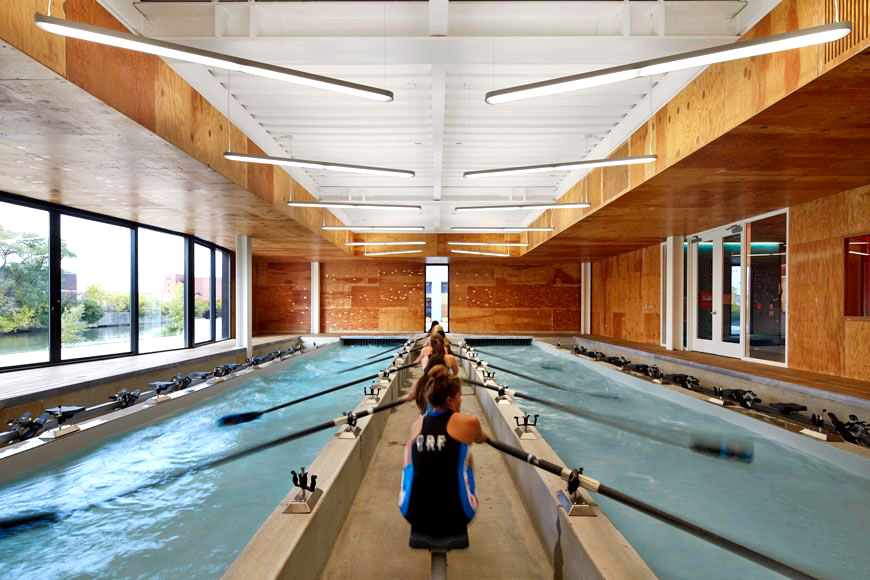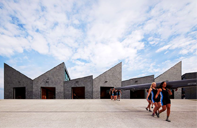
Rahm Emanuel noted in a 2011 press release that if Lake Michigan was Chicago’s “front yard,” then the Chicago River ought to be treated as the city’s “backyard,” and embraced as its “next recreational frontier.” In the press release, the mayor announced another step in the city’s decades-long attempt to completely revolutionize its riverfront: that is, to transform a vein of water so polluted that it has earned the nickname “Bubbly Creek” into a friendly and accessible destination for city residents. With $1 million in EPA funding, the city would construct four boathouses at various points along the riverbed, split evenly between the South and North Sides.
Two of these boathouses have been assigned to Studio Gang, the architecture firm behind the Aqua building in the Loop and the University of Chicago’s forthcoming Campus North Residence Hall. These two boathouses are the WMS Boathouse at Clark Park on the North Side and the boathouse at 28th and Eleanor Streets, in an area now known as “Park No. 571.” The boathouse at Clark Park was completed in 2013 to rave reviews from the Tribune and other publications; its diagonal design and repetition of “M” and “V” shapes beautifully mimic the motions of rowing. The two boathouses not designed by Studio Gang, at Ping Tom Memorial Park and River Park, are complete and under construction, respectively.
Right now, Park No. 571 is in no condition to receive rave reviews: the site of the fourth and final boathouse is currently a fenced-off lot, overgrown with vegetation and untouched by construction. Until the late 1960s, the patch of land was owned by Peoples Gas Light & Coke Co. (now simply Peoples Gas), and dominated by a natural gas plant that, as one resident, Jack (who declined to give his last name), remembers, shot flames “seventy-five feet into the air.” Peoples Gas eventually sold the land to the city of Chicago, and since then the “park” has remained empty and undeveloped. After the announcement of the boathouse project, however, the land was fenced off. Another resident recalled that people on Eleanor Street used to hang out down by the rocks on the edge of the river—an area known simply as “the rocks”—before it was fenced off completely.
Now, the only inhabitants of the weed-filled land where the boathouse is slated to be built are racks full of sixty-foot-long racing shells. Five Eleanor Street residents claim they have not heard anything from the city or Studio Gang about the proposed boathouse since the aforementioned 2011 press release. At least two residents had forgotten there was even a boathouse planned for their street.
Despite the increased traffic it would bring to Eleanor Street, most residents say they’re in favor of the boathouse. The area currently sees traffic from five rowing clubs: the Lincoln Park Boat Club, University of Chicago Crew, St. Ignatius High School Crew, the Chicago Training Center, and Recovery on Water, a rowing team of breast cancer survivors. All frequently park their cars on Eleanor before launching their boats. But if the Clark Park boathouse is any indication, the construction of the Eleanor boathouse would involve a full parking lot and significant beautification of the Eleanor Street block.
The Chicago Parks District responded to inquiries about the Eleanor boathouse by saying that they are “currently in the process of fundraising and working with local community groups and the Alderman [James Balcer of the 11th Ward] toward the completion of the fourth boathouse, with a planned location of 32nd [sic] and Eleanor.” Studio Gang has yet to release a plan for the boathouse, and said that interviews regarding the Eleanor site did not align with their current plan for public relations, recommending that we ask again in a few months.
Chicago has managed to revamp the downtown riverfront over the past forty years by building an extensive (and still in-progress) river walk along the water’s edge and erecting new condos along the near North Branch. Accomplishing this much in forty years is impressive, but the Loop was never home to natural gas plants and bubbly creeks; the riverfront restoration project on the South Branch, of which the two South Side boathouses are perhaps the first major component, is a vastly different project. It is not just the area around Eleanor and Ashland that is filled with rusting bridges and unkempt spaces, but the whole length of the river’s South Branch, which makes the city’s revitalization a larger project in remodeling an entire part of the city. Some residents of Eleanor Street see the lack of progress on the Bridgeport boathouse as a deliberate slight to the South Side by the city in its riverfront transformation efforts; only time, it seems, will tell if the city follows through on its ambitions of revitalizing both branches of the river.
“They used to cut the grass regularly, with the gas plant, but then [Peoples Gas] sold the land, and now I have to call and gripe and moan to get them to cut the grass,” said Jack, pointing to the overgrown field that is Park No. 571. “We [Bridgeport] got the short end of the stick as far as the river goes. We get stuck with the heliport, they changed flight paths so now the planes going into Midway fly over here, and look at that, no boathouse.”
Correction June 8, 2014: This article has been updated to reflect the full range of groups that currently row out of the Eleanor site.


It really would be nice if there was a true concerted effort to revitalize the river throughout the city. So much potential for making a variety of stops “must see” places for city inhabitants and visitors.
This also reminds me that I need to catch up on the plans for the riverwalk construction downtown.
Great piece, as always!
B
Bernard Edge, I’m prepared to build a team of volunteers to breathe life into the aforementioned portions of the City. Feel free to reach out to me, if possible, assuming you’d like to help the cause.
Best,
James